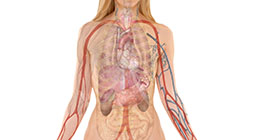Overview
Symptoms
Causes
Prescription
Health Tips
Ovarian cysts are common in women of childbearing age. Most women will not know they’ve had a cyst as there may be no symptoms and cysts will often disappear on their own. In a normal cycle every month, several follicles, each containing an egg, develop inside the ovary. A surge of luteinizing hormone and follicle-stimulating hormone helps release the egg, thereby causing estrogen levels to peak. When a drop in luteinizing hormone and follicle-stimulating hormone occurs, the follicle releases the egg, and progesterone increases. If the egg is not fertilized, the cycle starts all over again.
When an ovarian cyst develops, several follicles mature and enlarge in the ovary to become fluid-filled sacs or cysts. If, however, no egg is released, then no progesterone is secreted and more estrogen is released, thus maturing the follicles into cysts that will grow larger every month until progesterone is secreted. These types of cysts are called functional cysts.
Pathological cysts are cysts that are not due to the ovulation process. Though often benign, they are abnormal cell growths and may occur in both pre- and post-menopausal women on the ovary itself or in cells that once produced eggs. This type typically needs to be removed surgically.
Cysts may appear in a very short time and disappear just as quickly. Cysts can be alone or in groups, small or large—even as big as a lemon! When cysts become a few centimeters in diameter doctors will often recommend surgery. Cysts will usually reduce in size and disappear when a diet and supplementation program is followed.
Sometimes a follicle is able to grow tissue or skin cells within the cyst. These types of cysts must be surgically removed. The risk of cancer is present when those cysts become solid. Ovarian cancer is rare, but it is difficult to diagnose and remission rates with conventional medicine are poor.
Polycystic ovarian syndrome (PCOS) is an insulin resistant disorder in which many fluid-filled cysts are present and male hormones are excessively high. In this disorder, excess luteinizing hormone increases the production of male hormones that can cause acne and coarse hair growth.
Symptoms
Ovarian cysts are often not noticed until a woman receives a pelvic examination or an ultrasound scan. For those with symptoms, the most obvious symptoms include:
- Abdominal bloating
- A cyst eruption in the pelvic cavity resulting in blood and fluid discharge, possibly causing pain
- Pain during ovulation or intercourse
- Pain or tenderness to the touch, or a constant ache or burning sensation in the abdomen, localized in the lower abdomen off to the right or left
Those with PCOS will have ovarian cysts, increased coarse body hair, and high levels of luteinizing and male hormones.
Causes
Ovarian cysts are often due to hormonal imbalance and estrogen dominance. Exposure to xenoestrogens and poor elimination of waste by the lymphatic system, colon, liver, and kidneys are all potential factors. Emotional or physical trauma, prolonged stress, and even heavy exercise can cause an increase in estrogen. A diet rich in conventional meat, dairy, and soy products may also elevate estrogen. Cysts that occur after menopause should be reviewed by a physician as there is a greater risk of these being cancerous. The use of fertility drugs, birth control pills, or having never been pregnant increase the risk of ovarian cancer. Cysts may also be due to underlying conditions such as endometriosis or polycystic ovarian syndrome.
Prescription for Health
Improving diet, digestion and liver health, while avoiding environmental estrogens will be important in dealing with ovarian cysts.
| Nutrient | Dosage | Action |
|---|---|---|
| Multivitamin with minerals (contains no iron) |
As directed | Ensures adequate nutrient status |
| D-Chiro-Inositol | 600–1200 mg | Restores ovulation, normalizes male hormones, controls insulin, stops belly fat |
| Chromium | 200 mcg | Helps to normalize insulin levels |
| D-glucarate | 300 mg | Important for healthy metabolism of estrogen; stops abnormal cell growth |
| Curcumin (95% curcumin) | 100 mg | Prevents abnormal cell growth, detoxifies cancer-causing forms of estrogen |
| Indole-3-carbinol (I3C) | 300 mg | Eliminates excess toxic and cancer-causing estrogens; has been shown to reverse abnormal PAP tests within three menstrual cycles |
| Green tea extract | 200 mg | Protects against abnormal cell growth, detoxifies excess estrogens
Reduces new blood vessel formation in ovarian cysts and endometriosis. |
| Rosemary extract | 50 mg | Reduces tumor formation; is antioxidant |
| Di-indolylmethane (DIM) | 100 mg | Antioxidant; reduces risk of cancer |
| Sulforaphane | 400 mcg | Reduces risk of cancer; stops abnormal cell growth |
| Borage Oil | 2000 mg daily | Researched in estrogen receptor-positive-breast cancer |
Health Tips to Enhance Healing
- See Diabetes for tips on normalizing insulin and improving insulin resistance, which aids PCOS.
- Weight loss is essential in those with PCOS.











